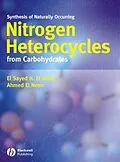Carbohydrates are widely distributed in nature and widely
available, and so are considered as a promising feedstock for the
preparation of many organic chemical compounds. They are
particularly useful in the preparation of nitrogen heterocycles
because of their related structural characteristics and easy
availability.
Synthesis of Naturally Occurring Nitrogen Heterocycles from
Carbohydrates will review the recent literature dealing with
use of carbohydrates as raw materials in the synthesis of these
materials. The text contains six chapters arranged according to the
complexity of the heterocyclic compounds discussed, ranging from
five to seven membered rings and from single to multiple fused
rings. The book provides a detailed discussion of the various
synthetic approaches to these compounds, using carbohydrate
starting materials, and does not merely reference synthetic
methodology but attempts to give as much detail as possible on the
actual experimental conditions used, in such a way that the chemist
can use the information directly to design a multi-step synthesis.
It discusses the different approaches to the synthesis of a wide
range of naturally occurring nitrogen heterocycles in a format that
enables the reader to make comparisons and decisions on whether to
use a certain procedure, to modify it, or to devise a new synthetic
methodology.
Autorentext
Professor El Sayed H. El Ashry1 Dr. Ahmed El Nemr 2
1 Department of Chemistry, Faculty of Science, Alexandria
University, Alexandria, Egypt.
2 Environmental Division, National Institute of Oceanography and
Fisheries, Kayet Bay, Alexandria, Egypt.
Zusammenfassung
Carbohydrates are widely distributed in nature and widely available, and so are considered as a promising feedstock for the preparation of many organic chemical compounds. They are particularly useful in the preparation of nitrogen heterocycles because of their related structural characteristics and easy availability.
Synthesis of Naturally Occurring Nitrogen Heterocycles from Carbohydrates will review the recent literature dealing with use of carbohydrates as raw materials in the synthesis of these materials. The text contains six chapters arranged according to the complexity of the heterocyclic compounds discussed, ranging from five to seven membered rings and from single to multiple fused rings. The book provides a detailed discussion of the various synthetic approaches to these compounds, using carbohydrate starting materials, and does not merely reference synthetic methodology but attempts to give as much detail as possible on the actual experimental conditions used, in such a way that the chemist can use the information directly to design a multi-step synthesis. It discusses the different approaches to the synthesis of a wide range of naturally occurring nitrogen heterocycles in a format that enables the reader to make comparisons and decisions on whether to use a certain procedure, to modify it, or to devise a new synthetic methodology.
Inhalt
Chapter 1 Five Membered Nitrogen Heterocycles.
1.1 Hydroxymethylpyrrolidines.
2-Hydroxymethyl-pyrrolidines.
Dihydro-2-hydroxymethylpyrrole (Nectrisine).
2,5-Dihydroxymethyl-pyrrolidines.
1.2 2-Carboxypyrrolidines.
Hydroxyprolines.
Bulgecins.
1.3 2-Aralkyl pyrrolidines.
Anisomycin.
Preussin.
1.4 2-Aryl pyrrolidines.
Codonopsinine and Codonopsine.
1.5 Miscellaneous.
Detoxins.
Gualamycin.
Lactacystin.
Chapter 2 Five Membered Heterocycles with two
Heteroatoms.
2.1 Hydantocidin.
2.2 Bleomycin.
2.3 Calyculins.
2.4 Acivicin.
2.5 Bengazole.
Chapter 3 Six Membered Nitrogen Heterocycles.
3.1 Hydroxymethylpiperidines.
Nojirimycin.
Mannojirimycin.
Galactonojirimycin.
Fagomine.
Homojirimycins.
3.2 Miscellaneous substituted piperidines.
2,6-Disubstituted-3-hydroxypiperidines.
Hydroxylated pipicolic acid.
Sesbanimide.
Siastatin.
Meroquinene.
Pyridyl of pyridomycin.
Chapter 4 Seven Membered Nitrogen Heterocycles.
4.1 Bengamides.
4.2 Liposidomycins.
Chapter 5 Fused Nitrogen Heterocycles.
5.1 3:5-Fused Heterocycles.
Azinomycins.
5.2 4:5-Fused Heterocycles.
b-Lactams.
5.3 5:5-Fused Heterocycles.
Polyhydroxypyrrolizidines.
Trehazolin.
Allosamidin.
Biotin.
5.4 5:6-Fused Heterocycles.
Hydroxylated indolizidines.
Castanospermine.
Swainsonine.
Lentiginosine.
Slaframine.
Miscellaneous.
Kifunensine.
Nagastatin.
Calystegines.
Mesembrine.
Streptolidine.
55 6:6-Fused Heterocycles.
Hydroxylated Quinuclidines.
Biopterins.
Isoquinolines.
Calycotomine.
Decumbenosine.
Laudanosine and glaucine.
Chapter 6 Multi-fused heterocycles.
6.1 Indoloquinolizidines.
Xylopinine.
Antirhine.
Allo-Yohimbane.
Ajmalicine.
6.2 Indolocarbazole Alkaloids.
6.3 Phenanthridone alkaloids.
6.4 Ecteinascidins
